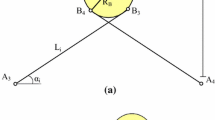Abstract
This paper addresses constrained robust optimal control of Cable-Driven Parallel Robots (CDPRs) in detail. In the CDPRs, cables should remain in tension for all movements. Based on this fact, considering tension constraints, a robust optimal control scheme is presented for the cable robots in this study. To develop the idea, at first, the general nonlinear dynamic model of the CDPR is converted to a State-Dependent Coefficient (SDC) linear structure. In this model, uncertainties of the cable robot are included as a vector in the SDC linear structure. Next, a constrained robust optimal control algorithm is proposed based on Hamilton-Jacobi-Bellman (HJB) equations and Karush-Kuhn-Tucker (KKT) conditions using the state-dependent coefficient parameterization form. The proposed control scheme is formed based on the Generalized State-Dependent Riccati Equation (GSDRE), and a new equation is created to counteract with disturbances and uncertainty of the CDPR model. Finally, the stability of the closed-loop system is proved using Lyapunov’s second method. Simulation results show the effectiveness of the proposed control algorithm in terms of tracking and coping with the uncertainties and external disturbances.










Similar content being viewed by others
Data availability
Enquiries about data availability should be directed to the authors.
References
Khosravi, M.A., Taghirad, H.D.: Dynamic analysis and control of cable driven robots with elastic cables. Trans. Can. Soc. Mech. Eng. 35(4), 543–557 (2011)
Khosravi, M.A., Taghirad, H.D.: Robust PID control of fully-constrained cable driven parallel robots. Mechatronics 24(2), 87–97 (2014)
Zi, B., Duan, B., Du, J., Bao, H.: Dynamic modeling and active control of a cable-suspended parallel robot. Mechatronics 18(1), 1–12 (2008)
Oh, S.-R., Agrawal, S.K.: Generation of feasible set points and control of a cable robot. IEEE Trans. Rob. 22(3), 551–558 (2006)
Kawamura, S., Kino, H., Won, C.: High-speed manipulation by using parallel wire-driven robots. Robotica 18(1), 13–21 (2000)
Hervé, J., Sparacino, F.: “Structural synthesis of parallel robots generating spatial translation,” in Proceedings of the 5th IEEE international conference on advanced robotics, pp. 808–813, (1991)
Babaghasabha, R., Khosravi, M.A., Taghirad, H.D.: Adaptive robust control of fully-constrained cable driven parallel robots. Mechatronics 25, 27–36 (2015)
Santos, J.C., Gouttefarde, M., Chemori, A.: A nonlinear model predictive control for the position tracking of cable-driven parallel robots. IEEE Trans. Rob. 38(4), 2597–2616 (2022)
Bettega, J., Piva, G., Richiedei, D., Trevisani, A.: Model predictive control for path tracking in cable driven parallel robots with flexible cables: collocated vs. noncollocated control. Multibody Syst Dyn 58, 1–35 (2023)
Sancak, C., Yamac, F., Itik, M.: Position control of a planar cable-driven parallel robot using reinforcement learning. Robotica 40(10), 3378–3395 (2022)
Côté, A.F., Cardou, P., Gosselin, C.: A tension distribution algorithm for cable-driven parallel robots operating beyond their wrench-feasible workspace, in 2016 16th International conference on control, automation and systems (ICCAS), pp. 68–73, IEEE, (2016)
Pott, A.: An improved force distribution algorithm for over-constrained cable-driven parallel robots, in Computational Kinematics: Proceedings of the 6th international workshop on computational kinematics (CK2013), pp. 139–146, Springer, (2014)
Batiha, B., Noorani, M., Hashim, I.: Application of variational iteration method to a general Riccati equation. Int. Math. Forum 2, 2759–2770 (2007)
Çimen, T.: State-dependent Riccati equation (SDRE) control: a survey. IFAC Proc. Vol 41(2), 3761–3775 (2008)
Korayem, M., Nekoo, S.: Finite-time state-dependent Riccati equation for time-varying nonaffine systems: rigid and flexible joint manipulator control. ISA Trans. 54, 125–144 (2015)
Cloutier, J.R., D’Souza, C.N., Mracek, C.P.: Nonlinear regulation and nonlinear \(h_{\infty }\) control via the state-dependent riccati equation technique: Part 1, theory, in Proceedings of the international conference on nonlinear problems in aviation and aerospace, pp. 117–131, Embry Riddle University, (1996)
Nocedal, J., Wright, S.: Numerical Optimization. Springer Science & Business Media, Berlin (2006)
Kirk, D.E.: Optimal Control Theory: An Introduction. Courier Corporation, North Chelmsford (2004)
Bryson, A.E.: Applied Optimal Control: Optimization, Estimation and Control. CRC Press, Boca Raton (1975)
Funding
The authors have not disclosed any funding.
Author information
Authors and Affiliations
Corresponding author
Ethics declarations
Conflict of interest
The authors declare that they have no conflict of interest. The authors declare that no funds, grants, or other support were received during the preparation of this manuscript.
Additional information
Publisher's Note
Springer Nature remains neutral with regard to jurisdictional claims in published maps and institutional affiliations.
Appendices
Appendix: Dynamics parameters
By choosing the parameters \(2.25\left( \varvec{kg} \right) \le m \le 2.75\left( \varvec{kg} \right) \), \(0.01\left( \varvec{kg} {\varvec{m}^2} \right) \le {I_z} \le 0.07\left( \varvec{kg} {\varvec{m}^2} \right) \), and \(g = 9.806 \left( \varvec{m} {{\varvec{s}^2}} \right) \), the dynamic matrices of the 3 DoFs planar CDPR are expressed as follows [2]:
The position of the cable attachment points is selected as [2].
Appendix: Calculations
Consider the following defined remarks:
Remark 1
The symbol \(\left[ \hspace{-1.49994pt}\left[ {.} \right] \hspace{-1.49994pt}\right] \) indicates that the inside parameter is a vector, e.g.,
which N is the number of the vector elements.
Remark 2
The symbol \(\left\{ . \right\} \) indicates the tensor space in which the inside parameter dimensions must be homogenized according to the problem.
Remark 3
\({\theta _{i:}}\) and \({\theta _{:i}}\) represent the \(i_{th}\) row and \(i_{th}\) column of matrix \({\theta }\), respectively.
The derivatives of the matrices Q(z(t)), R(z(t)), and Y(z(t)) in terms of z(t) algebraically create more comprehensive dimensions than Q(z(t)), R(z(t)), and Y(z(t)). We use the following three tensor relations to perform accurate calculations.
Also, one can write,
Rights and permissions
Springer Nature or its licensor (e.g. a society or other partner) holds exclusive rights to this article under a publishing agreement with the author(s) or other rightsholder(s); author self-archiving of the accepted manuscript version of this article is solely governed by the terms of such publishing agreement and applicable law.
About this article
Cite this article
Marufkhani, H., Khosravi, M.A. Robust optimal constrained control of fully-constrained cable-driven parallel robots based on GSDRE. Nonlinear Dyn 111, 16159–16174 (2023). https://doi.org/10.1007/s11071-023-08693-3
Received:
Accepted:
Published:
Issue Date:
DOI: https://doi.org/10.1007/s11071-023-08693-3




